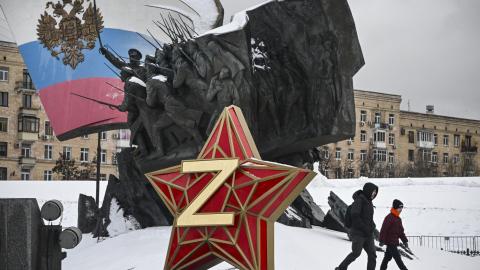It’s been two years since Russia launched its war to subjugate Ukraine in February 2022. It’s time to take stock, recall how we got here, and what Americans should demand moving forward.
Russian president Vladimir Putin has imperialistic goals and is ultimately to blame for the decision to invade Ukraine. Ukraine, in the real world and not in the paranoid fever dreams of the ex-KGB officer Putin, posed no threat to Russia. If you watched Tucker Carlson’s interview with Putin, you heard Putin say what he’s been saying for years. He made claims to Russian territory and ethnic Russian people and referenced historical events all the way back to the 9th century that he believes entitled Russia to start wars. That is a ‘forever war’ mentality if there ever was one.
Putin rejects the peace that President Ronald Reagan negotiated with Mikael Gorbachev. He called the negotiated end of the Cold War which averted devastating war and preserved peace the “greatest geopolitical catastrophe of the century.”
Despite the efforts of US presidents to develop friendly relations with Russia (recall President Barack Obama’s infamous Russia reset and hamburgers with then Russian President Demitri Medvedev), Putin despises the United States. American good faith efforts to demonstrate it has no interest in conflict with Russia, Germany’s delusional fostering of Russian energy interests, and some European nations’ ongoing reluctance to adequately invest in their militaries, have not convinced Russia to choose peace.
Instead, NATO’s relative weakness and US attempts to reassure and allay Russian purported concerns have only fueled Russian contempt and appetite for war.
When the Biden administration came to power, its series of decisions, convinced Putin that that was the right time to invade.
For example, in May 2021, Biden lifted the Trump sanctions on the Nord Stream 2 pipeline; those sanctions had prevented Russia from increasing its energy collaboration with Germany while cutting off Eastern and Central European countries. Team Biden also lifted sanctions on a longtime Putin crony and the head of the NS2 project.
Just a few months later, Biden directed the precipitous withdrawal from Afghanistan, which was a NATO mission. Biden refused to discuss the events with key members of the alliance including then UK Prime Minister Boris Johnson who was desperately trying to reach the American president. Biden’s behavior left NATO nations reeling.
As Russia began amassing troops on Ukraine’s border, the Biden administration withheld Congressionally-approved weapons to Ukraine in an effort to appease Russia. Then Biden White House lawyers, seized by fear of escalation, dragged its heels on authorizing Lithuania and Latvia delivery of key air defense systems. It finally approved those weapons but the pattern of refusing to deliver or approve of the weapons Ukraine needs (remember it blocked those Polish fighter jets after initially expressing support) to successfully defend itself and push Russia out of its territory continued. Even now, the Biden White House refuses to deliver longer range strike systems to Ukraine and will only let Ukraine use US weapons to hit Russian forces inside Ukraine, effectively giving Russia the advantage by granting its war efforts sanctuary inside Russia.
Despite handcuffing Ukraine and refusing to provide it with the necessary weapons, Ukraine has reclaimed 50% of the territory Russia stole in the initial campaign. It has inflicted more than 300,000 casualties against Russian forces, taken out 30% of Russia’s Navy in the Black Sea, and significantly degraded the Russian army. A weaker, chastised Russia is very good for American security. But if Ukraine isn’t given the weapons it needs and the permission to use them in the way it needs to, Ukraine will lose and Russia will pocket the gains, replenish its military, and look for its next move to divide and ultimately dismantle the US-led alliance in Europe.
But a new strategy is needed and a plan to surge weapons to Ukraine is possible. The US manufacturing base has dramatically atrophied since the Cold War. But US supply of weapons to Ukraine has forced overdo changes to the way the US makes weapons. In manufacturing plants across the country, more Americans are being hired to increase the US ability to make weapons in higher numbers and faster. More must be done, but this is a good start.
Former President Donald Trump has not opposed more weapons to Ukraine, although he has said that if he was elected, he would end the war in 24 hours. When pressed on what he would do if Putin did not accept his terms for the end of war, he said would tell Putin: “If you don’t make a deal, we’re going to give them a lot. We’re going to give them more than they ever got, if we have to.” For Trump to have leverage to credibly make good on that promise, he needs a robust manufacturing ability and Ukraine needs to have a much better hand to play than it has now.
The smartest, most principled steps for the near term would be for Congress to rush weapons to Ukraine and invest in the US weapons replenishment and stocks. Failing to do that now helps Russia and deprives the next President of options.
Russia will remain a chronic threat to the United States. Putin and the CCP’s Xi will not end their efforts to harm the United States and our allies even after the war in Ukraine comes to an end.
To preserve the peace in this new cold war and deter aggression from the axis of China, Russia, Iran, and North Korea, the United States must do exactly what President Reagan did: prepare for major war, pressure and lead allies to help us, and convince our enemies that we have the ability and will to win.














